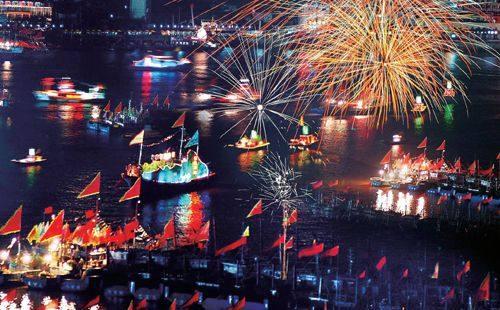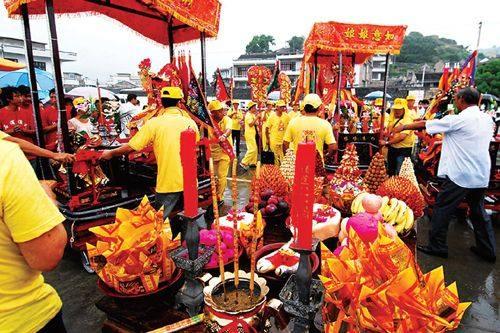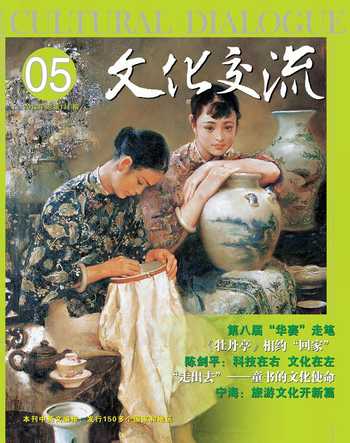象山渔文化 两岸总关
2012-04-29丁华陈光曙邱明亮
丁华 陈光曙 邱明亮



在中国大陆的中部沿海有一个海内外著名的渔港,它就是石浦渔港。它是我国东南沿海著名的国家中心渔港,十八里港湾岛山环屏,五门罗列,可泊万艘渔船,可航万吨海轮,早在汉时就被人们认识利用。数以万计的渔船装卸渔货、补给物资,桅樯林立、渔火灿烂。特别是海鲜之多,实属罕见。400多种鱼类、100多种甲壳类、80多种贝类在这里汇聚,流向世界,石浦因此被誉为海鲜王国。
颇具特色的海洋文化是渔港石浦的一大特色,而由此衍生的渔文化,更是海洋文化中的瑰宝。石浦的渔港、渔区、渔村、渔民、渔宅、渔盐、渔埠、渔汛、渔事、渔行、渔节、渔商、渔史、渔谚、渔俗、渔具、渔服、渔饰、渔船、渔风、渔食、渔市、渔歌都是宝贵的文化遗产。
春风骀荡,万紫千红。石浦渔港的海峡广场热气腾腾。地面6000平方米、地下6000平方米,用于两岸交流和旅游接待的海峡广场,2012年5月1日对外开放。
象山县委书记李关定对我们说,在长期与海共舞的实践中,我们的祖先逐渐形成了渔区独有的风俗、信仰与崇拜。它包括渔谚、鱼的传说等口头传统,造船、织网、渔具制作等传统技艺,航海知识、捕捞技能、妈祖巡游、祭海仪式、开渔节、渔民宅居、渔民饮食、渔业商贸等信仰和习俗,及其相关的渔歌、渔曲、渔戏、渔鼓、渔灯等各种艺术表现形式。底蕴丰厚的渔文化,成为象山人的一种特殊的文化符号。
台湾商品 石浦直销
在石浦渔港的大庆路上有一家新开张的台湾商品购物中心,今年春节刚过我们就来到了这家台湾商品购物中心。“台湾印象”四个繁体大字特别引人注目,来到这里就让我们感到买台湾商品其实不一定非得去台湾,只要到这家商店就能买到各种货真价实的台湾货。这里有大名鼎鼎的台湾金门高粱酒和其他许多牌子的台湾原产各类白酒和红酒,还有五花八门的袋装食品、各类品牌的台湾产洗涤用品和一件件渔民特别喜欢的羽绒服等。
如今,在石浦的平常百姓家里,我们都可以看到台湾牛肉干、台湾怪味花生豆、台湾薯条等许多台湾产的零食。
这家购物中心去年年前开业,到年底才渐成规模,这是浙江省第一家销售台湾日常生活用品的超市。店主潘老板是一位地道的石浦人,他指着货架上琳琅满目的台湾商品告诉我们:“超市经营面积300多平方米,销售食品、饮料、洗涤用品、日用品、调味品等5大类4000多种商品,全部都是从台湾运来的。最受石浦人喜欢的是台湾的洗涤用品、化妆品和金门高粱酒。”
说话间,石浦居民陈先生来到超市购买方便面。他告诉我们,台湾产的牛肉方便面,配料是牛肉片,不是牛肉粉末或颗粒,很好吃,他特地过来买点换换口味。另一位顾客则喜欢上了这里销售的金门高粱酒。“金门高粱酒名气很响,口味很淳香纯正,喝了不上头,价格也不贵,招待亲戚最好不过了。”
两岸经贸合作石浦实验区筹备委员会办公室的一位负责人对我们说:象山石浦是全国首批5个对台小额贸易试行及开放管理措施的试点口岸之一,这些商品全部是通过石浦这个宁波唯一的“对台小额贸易”口岸进来的。基本上每星期都会有一个集装箱的货发过来,保证货物的供应。
两岸石浦 一脉相承
来到象山,渔具、渔船、渔场、渔港、鱼汛、渔灯、渔歌、渔曲、渔鼓、海鲜“十六碗”等原生态的渔文化俯拾皆是。
更让人印象深刻的是:在大陆的象山有一个石浦镇,而在海峡对面的台湾岛上也有一个同名同姓的石浦村。
说起台湾岛上的石浦村,不得不提起海内外著名的台湾艺人、特技演员柯受良。柯受良1953年出生于象山县石浦渔港外海、和台湾岛隔海相望的渔山列岛上。他两岁时随父亲移迁台湾并定居在台东。他酷爱音乐,擅长卡拉OK,1980年曾获得香港电影导演卡拉OK赛的冠军。他曾经驾摩托车飞越万里长城及西藏布达拉宫。1997年6月1日驾汽车飞越黄河壶口瀑布以庆祝香港回归,有“中国第一飞人”的称号。2003年12月9日上午在上海身亡,终年50岁。浓浓的爱乡情结,使他为家乡的建设做出了不少贡献。为纪念他,人们在石浦渔港老街专门建造了“亚洲第一飞人馆”。纪念馆里那辆插着鲜艳五星红旗的赛车,和他骑着摩托车飞过黄河、飞过布达拉宫、飞过金山岭长城的虚拟实景,着实让人激动而感慨。
当年,石浦渔山岛上的93户村民487人来到台湾,定居在台东县的富冈新村,村民们难忘故土,就将台湾台东的富冈新村称为“小石浦村”。
隔海相望,一脉相承。变的是不同的生活方式,而不变的是永远的乡风乡情。随着两岸关系的改善,兩岸石浦人也同时开辟了一段传奇的文化交流。
如意信俗 同祖同宗
当年,象山石浦渔山岛的村民迁居台湾时,并没有带走多少家当,但渔民们却把岛上“娘娘庙”里的“如意娘娘”等大大小小神像悉数“请”到了台湾。
如意信俗是石浦妈祖信俗的组成部分,也是石浦渔山岛人特有的传统文化形态。
相传如意娘娘原为渔山岛上一个善良、孝顺、勇敢的渔家少女。有一天,如意的父亲出海捕鱼遇难,当她得知噩耗后,万分悲痛。第二天,如意就跟船出海,想要寻找父亲的遗体。当渔船行至父亲落海处时,已寻不到父亲的一丝踪影。如意悲从心起,奋不顾身冲向大海,瞬时消失在滚滚浪涛之中。船上渔民见如意跳海,赶忙寻找,但早已无影无踪。不久后,在如意跳海处浮起一段大木头,渔民们就将这段木头雕刻成一尊如意神像,建起了娘娘庙供奉。
数百年来,如意娘娘成了渔山岛渔民的海上保护神。渔民出海捕鱼前要举行“开洋”仪式,捕鱼回家时则举行“谢洋”仪式,以此来祭祀如意娘娘,保佑自己平安、丰收。一代代的渔山岛人,就在这种神奇的传统信俗和美丽的精神慰藉中成长起来,如意信俗,已经成为他们精神生活中不可缺少的元素。这是他们用自己的情感、智慧和理念创造的一个传奇,反映了渔山岛人对人生的独特理解和对美好生活的不懈追求。
当年,渔山岛居民“撤离”去台湾时,奉持着娘娘庙的大小神像一起上船,最大的这尊如意娘娘(如意真身)高五尺,很沉,手脚可以活动拆卸。定居到小石浦村后,人们建起了“海神庙”供奉如意娘娘。
2007年7月27日,阔别故乡五十多年的如意娘娘终于踏上了回家认亲的道路。这一天,台湾小石浦村回乡祭祖团一行54人,奉持如意娘娘塑身从台湾转香港飞抵宁波,来到石浦渔山岛认亲省亲,与渔山岛村民一起举行了盛大的祈福祭典活动。
在第十届中国(象山)开渔节期间,又有40位小石浦村代表护送着如意娘娘真身来到石浦,与石浦东门天后宫的妈祖娘娘作省亲迎亲活动。当晚,还在灯火通明的石浦渔港举行了两岸娘娘巡安暨烟火大会,盛况空前。此后,海峡两岸的亲人藉着如意娘娘的灵气,一次又一次地走到了一起,共同祈祷两岸人民风调雨顺、国泰民安。
2008年6月,象山县上报的“石浦富冈如意信俗”文化项目被国务院公布为第二批国家级非物质文化遗产。作为非物质文化遗产,“石浦富冈如意信俗”有其特别之处,那是海峡两岸石浦人一脉相承的古俗,其独特的历史背景和丰厚的文化内涵印证了海峡两岸人民同祖同宗、血脉相连的事实,是中国非物质文化遗产百花园中的一朵奇葩。
象山人多年来精心呵护的渔文化如今有了丰厚的回报,现在象山拥有石浦妈祖信仰及迎亲习俗、象山开洋与谢洋节、象山晒盐技艺、徐福东渡传说、渔家号子、象山唱新闻等6项国家级非物质文化遗产,38项浙江省和宁波市非物质文化遗产,其非物质文化遗产之多名列浙江省全省第一。2008年象山还被文化部授予“中国渔文化之乡”。
目前,象山县正在全力建设浙江省海洋综合开发与保护试验区和两岸经贸合作石浦实验区,在提交浙江省政府的《象山海洋综合开发与保护试验区规划》中,未来的象山将打造成为浙江省对台经贸合作区。
象山縣委书记李关定对两岸经贸合作石浦实验区的建设充满了信心。象山县将努力创新开发管理体制,深化对台交流合作,做大做强对台小额贸易,试点开放两岸货币双向兑换,还将争取获批浙江省首个“海峡两岸交流基地”,成为对台交流合作和体制机制创新的示范区。□
(本文照片除署名外,均由象山县新闻办公室提供)
Cultural Ties between Xiangshan and Taiwan
By Ding Hua, Chen Guangshu, Qiu Mingliang
Situated in the midpoint of the coastline of Zhejiang Province, Shipu in Xiangshan is a central fishing port. The coastal line here is perfect for ships to dock and moor. The port here can be home to ships from small ones up to 10,000-tonners. The port goes back to the Han Dynasty. It is a common sight that tens of thousands of fishing ships are in the port, unloading catches and loading supplies for the next fishing trip. Shipu now doubles as a living museum of fishing culture and tradition. The fishing port is surrounded by fish-ing villages where fishing garments, ornaments, fishing tools, cus-toms, food, songs, and proverbs are all part of a life that flourishes through fishing. Naturally, Shipu is a central trading marketplace for seafood. More than 400 species of fish, over 100 species of crustaceans and about 80 species of mollusks are traded here and then shipped out to retailers.
Shipu Town in Xiangshan and Little Shipu Village in Taiwan have close ties. In1949, the mainland was nearly all liberated but some islands in Zhejiang were under the control of the Kuomintang troopers. In January 1955, the Peoples Liberation Army seized Yi-jiangshan Island. After the fall of this strategic stronghold, the KMT troopers on Dachen Island did not have a shield any more. In Feb-ruary, the KMT troopers withdrew from these islands and moved back to Taiwan. The withdrawal was escorted by the 7th Fleet of the USA navy. On their way out, the troopers evacuated all the resi-dents on these islands and carried them to Taiwan.
Four hundreds and eighty-seven residents of 93 households on Yushan Island, Shipu were part of the population that went to Tai-wan under the gun in 1955. They settled down in Fugang, Taidong County in Taiwan. They called their new settlement Little Shipu. When they came to Taiwan, they carried few personal belongings, but they carried their statues of goddesses from their households and the village temple. The goddess the residents worshiped is Lady Ruyi. The largest statue is five-foot tall. Its hands and legs are removable. When it was removed from the village temple, the hands and legs were separately packed and the torso was carefully wrapped with a piece of red fabric. After Little Shipu came into be-ing, a Sea God temple was built and the statue was placed for wor-shiping. The regional folk religion flourished in Little Shipu. Lady Ruyi is part of the popular Mazu worship in Zhejiang.
On July 27, 2007, a group of 54 residents from Little Shipu in Taiwan escorted the statue back to Yushan Island for a reunion. A worship ceremony was held. In September 2007, the statue came back to Shipu Town to be present at the 10th China Fishing Fes-tival. A grand ceremony was held in celebration of the reunion of statue of Mazu and the statue of Lady Ruyi. After the ceremony, a firework gala was held. In June 2008, Lady Ruyi Worship was of-ficially recognized as a national intangible cultural heritage. Nowa-days Xiangshan Count boasts six national intangible cultural herit-ages, all intimately embedded in fishing, the life and pillar industry of the county on the sea since very ancient times.
Arguably, the most famous personage of Shipu is Blackie Ko Sau-leung (1953-2003). He was born on Yushan Islands. At the age of two, he moved to Taiwan with all the islanders. He was a famed stuntman, actor, director and singer. He established his name on the mainland by jumping over the Great Wall on his mo-torcycle in Beijing in 1992 to raise money for the China Sports Foundation. In 1997, he successfully jumped 55 meters over Hukou Waterfall on the Yellow River in a sports car. He was crowned Asias No. 1 Flying Man. Ko made contributions to the prosperity of his Shipu. In a street in the old town of Shipu is a museum in honor of the son of Shipu. On display are his sports car and many photos capturing the moments of his famous stunts.
The intimate ties between Xiangshan and Taiwan are more than the ties between Shipu Town in Xiangshan and Little Shipu in Taiwan. In Daqing Road, Shipu, there is a shopping center for Tai-wan commodities. The 300-m2 store offers 4,000 brands of food, beverage, condiments, laundry, and other household pieces. All the commodities are directly shipped in from Taiwan. Buyers in Shipu do not need to go to Taiwan to buy these made-in-Taiwan things. The most popular buys are a wine made in Jinmen Island and down jackets, which are favorable necessities by fishermen for a life on the sea.
Shipu is one of the five areas in a pilot trade project between the mainland and Taiwan. The goods available in the shopping center are all directly shipped in a standard container form Taiwan once a month. The daily sales volume is averagely 6,000 yuan. If business is good, more shops will be opened in Ningbo and other cities. □
